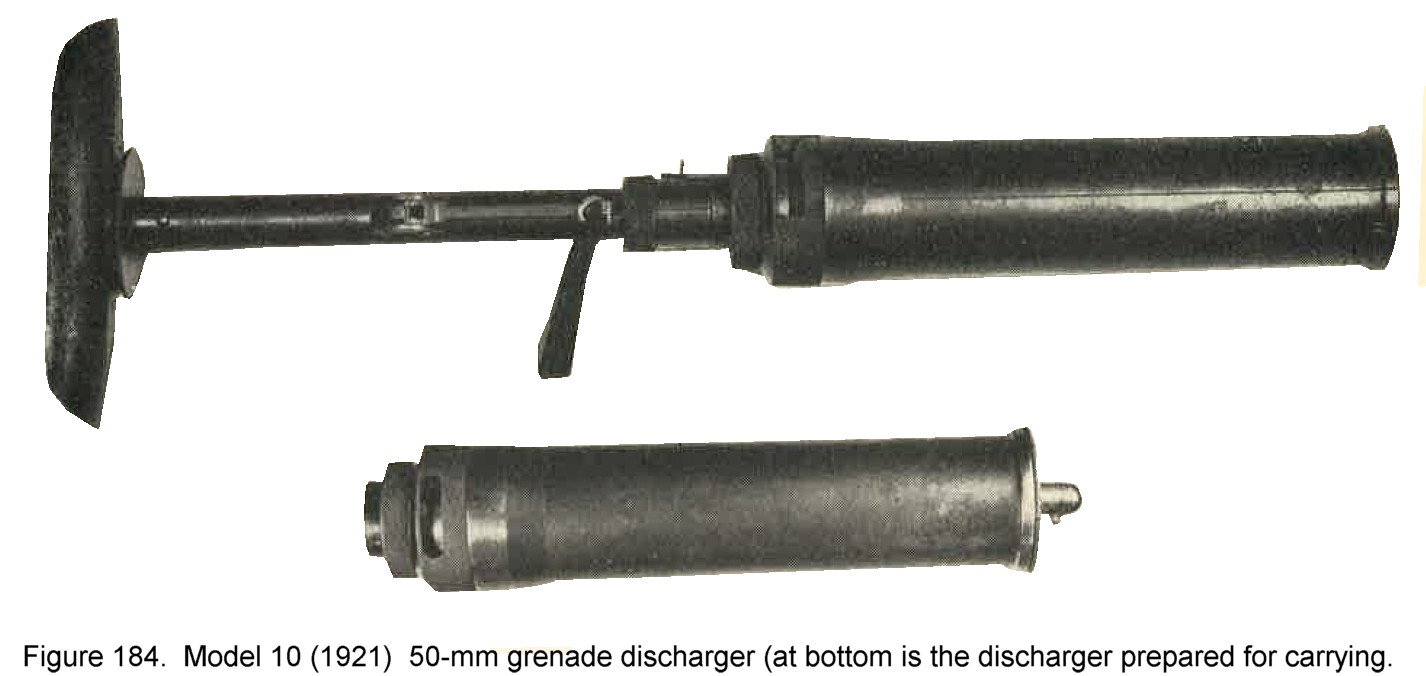CHAPTER 9 SECTION b - GRENADES AND LAND MINES

3. WWII JAPANESE MORTARS AND GRENADE DISCHARGERS.
a. General. Although all know types of both mortars and grenade dischargers are dealt with here, there are indications that the Japanese Army has mortars heavier than 90-mm and at least up to 150-mm.
b. Model 10 (1921) 50-mm grenade discharger.
(1) General description. This is a smooth bore, muzzle loaded weapon (figure 184). It has the special feature of a rnage control device in the form of a graduated thimble by which a gas port at the base of the tube can be varied in size. For shorter ranges, part of the propellant gases escape to the side. It is believed that this weapon is used primarily for discharging flares and that the heavier Model 89 grenade discharger is used for firing high explosive and other projectiles.
(4) Ammunition. This weapon fires: - Model 91 grenade,
- Model 11 smoke shell,
- Model 10 flare shell,
- Model 10 signal shell,
- Model 91 pyrotechnic grenade,
- Model 10 blank.
C. Model 89 (1929) 50-mm grenade discharger.
(1) General description. This is a muzzle fed, rifled weapon which is widely used in the Japanese Army (figure 185). The standard projectile is a high explosive shell which contains the propellant charge in its base. Ranges are controlled by rotation of the knurled range knob. Rotation of the projectile is obtained because the rotating band is expanded against the rifling when the weapon is fired. The weapon is trigger fired. A recent modification of the discharger is fitted with a device to indicate the correct firing angle (45 degrees).
There are two range scales. One gives the ranges (120 to 670 meters) governing the use of the Model 89 HE shell and the other (50 to 170 meters) is used for firing Model 91 grenade.
(2) Characteristics.
(3) Ammunition. The following types of ammunition are known to be provided; - Model 89 high explosive shell. - Model 91 grenade. - Smoke shell - Model 94 practice shell - Pyrotechnic signals (described in chapter 10) - and incendiary (figure 186). |
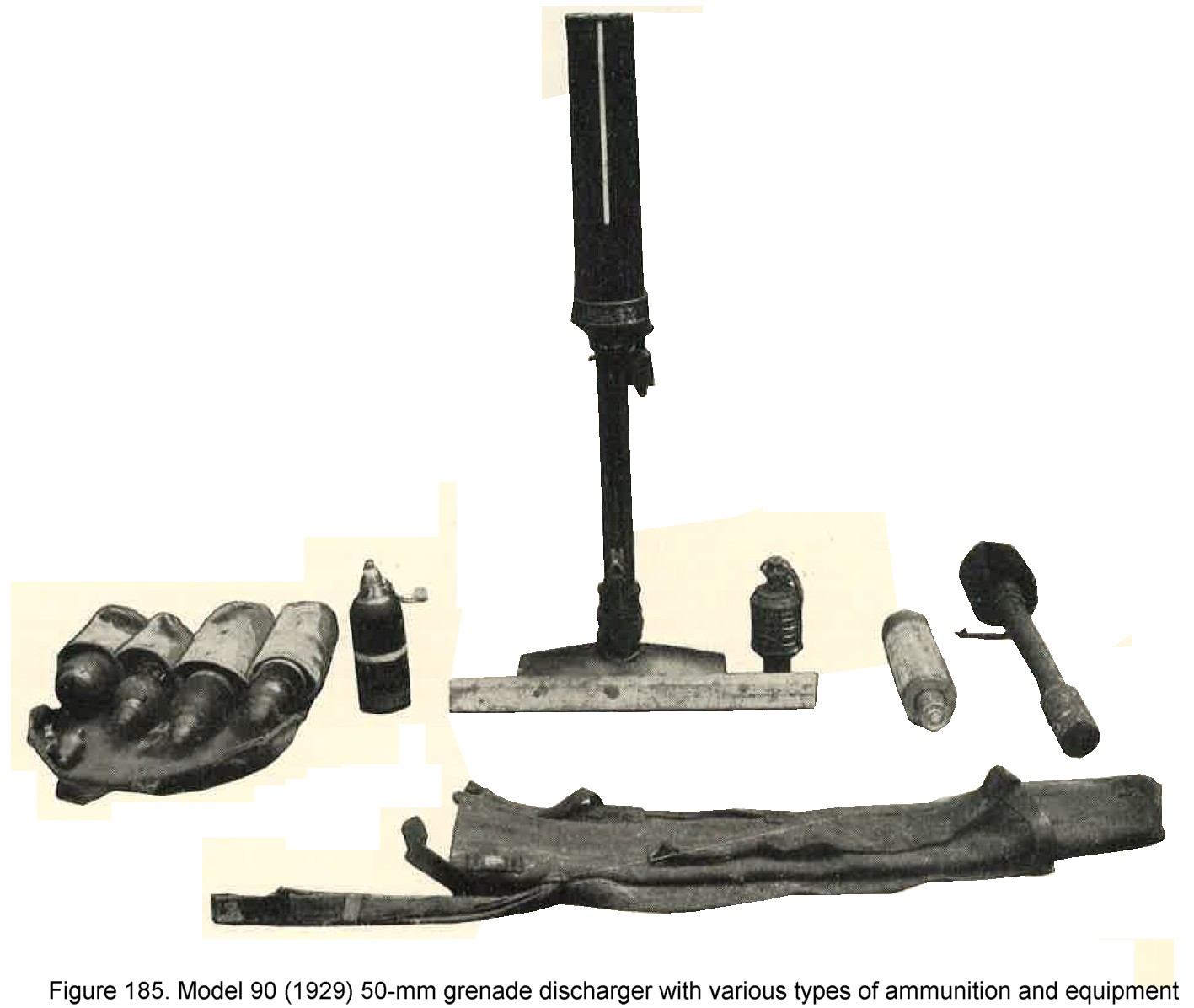 |
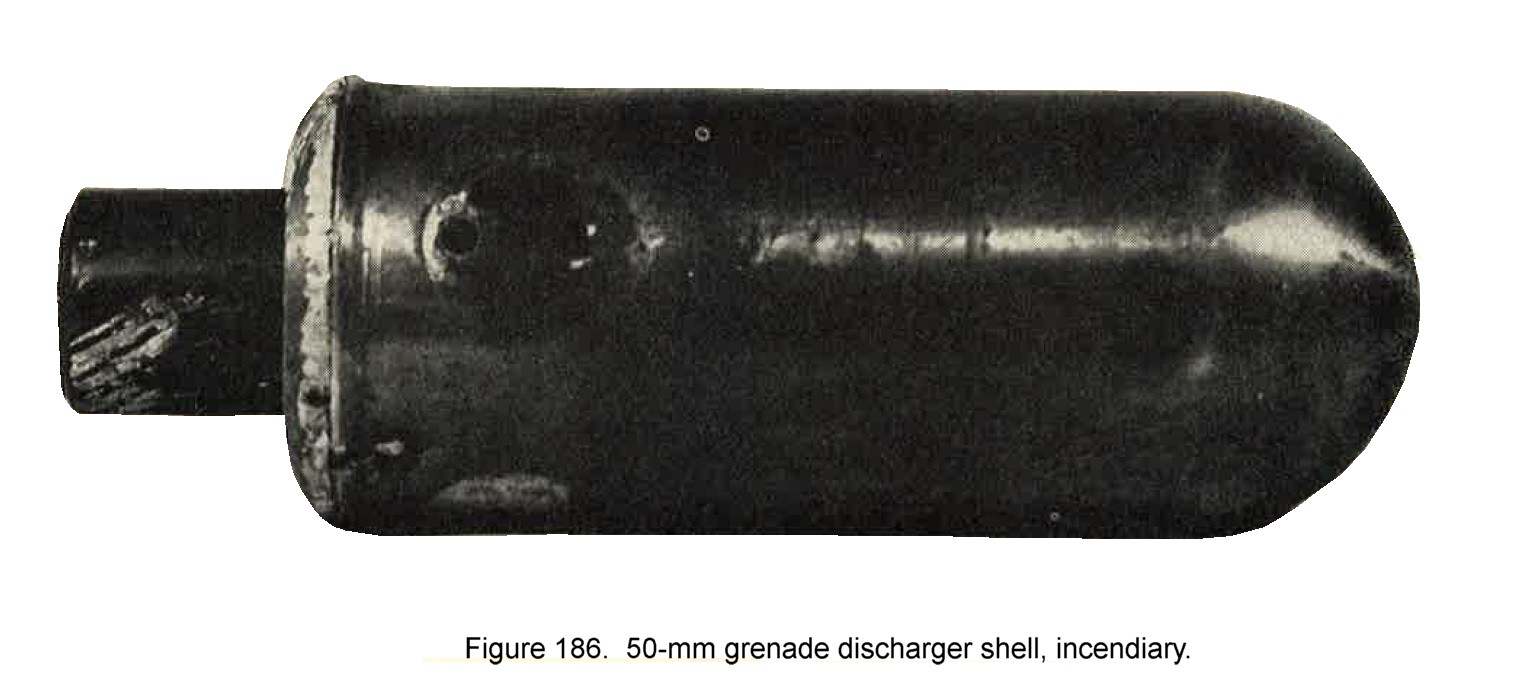
|
The incendiary shell has a light metal body and weighs approximately 1.25 pounds. It contains about 0.7 pouns of incendiary mixture. The smoke shell weighs approximately 2 pounds, contains about 4 ounces of HC type smoke mixture. The body has the same shape as the high explosive shell, but may be distinguiushed by having two white bands on the body. |
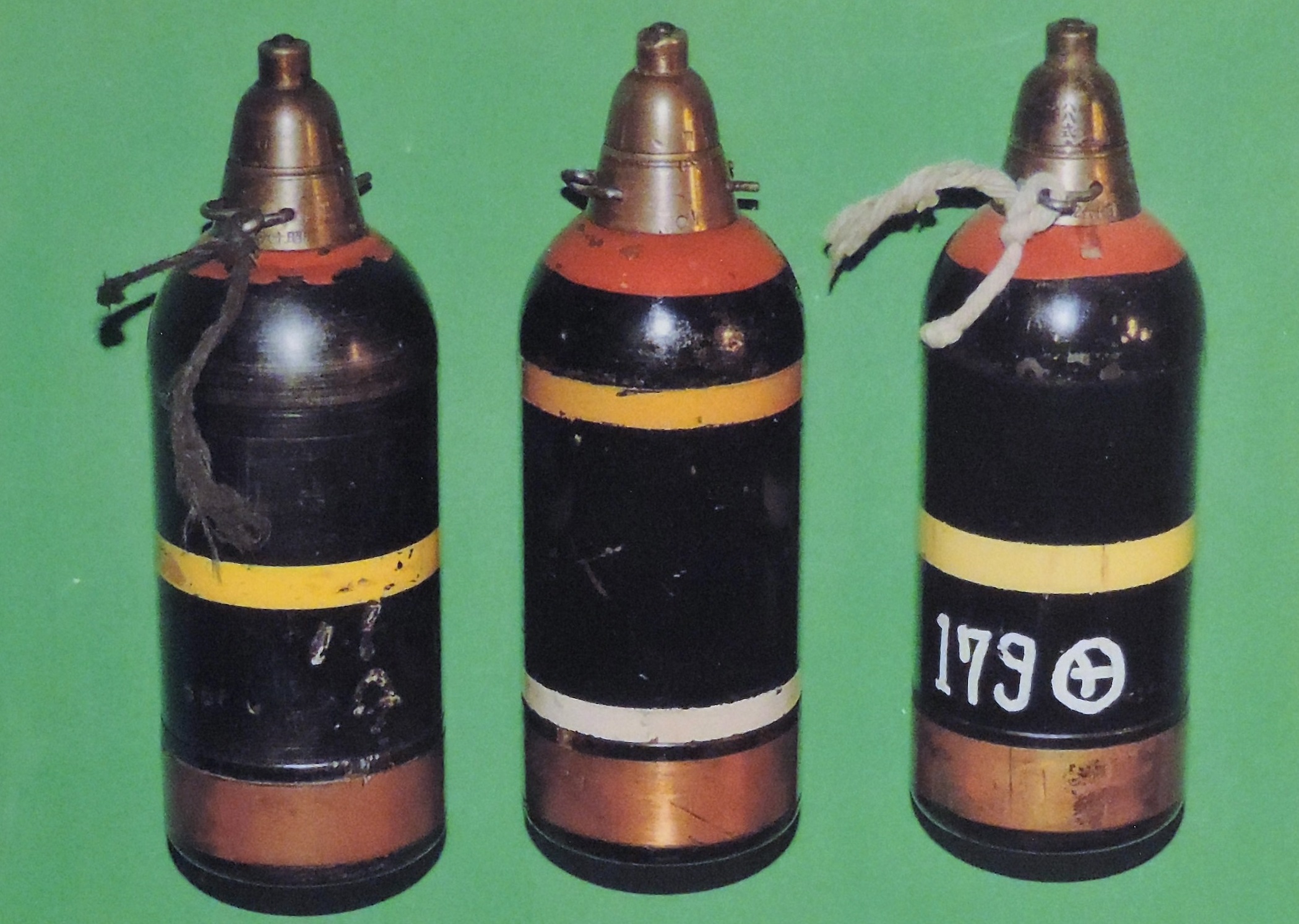
Figure 185-a. WWII Japanese High Explosive knee mortar rounds.
d. Model 98 (1938) 50-mm mortar.
(1) General description. This is a smooth bore muzzle loaded weapon with fixed elevation of approximately 40 degrees and limited traverse (figure 187). It is fired by a lanyard attached to a friction primer affixed to the base of the tube. A special feature is a range slide which may be clamped to the muzzle. This regulates the length of the stick (spigot) extending into the barrel. The greater the distance the stick extends into the barrel, the greater the range.
(2) Characteristics.
(3) Ammunition. The weapon fires a stick bomb weighing approximately 10 pounds and containing 7 pounds of picric acid in blocks. A smaller bomb containing 5 pounds of picric is also used. A finned bangalore torpedo may also be fired. No other ammunition has been recovered to date (1944). |
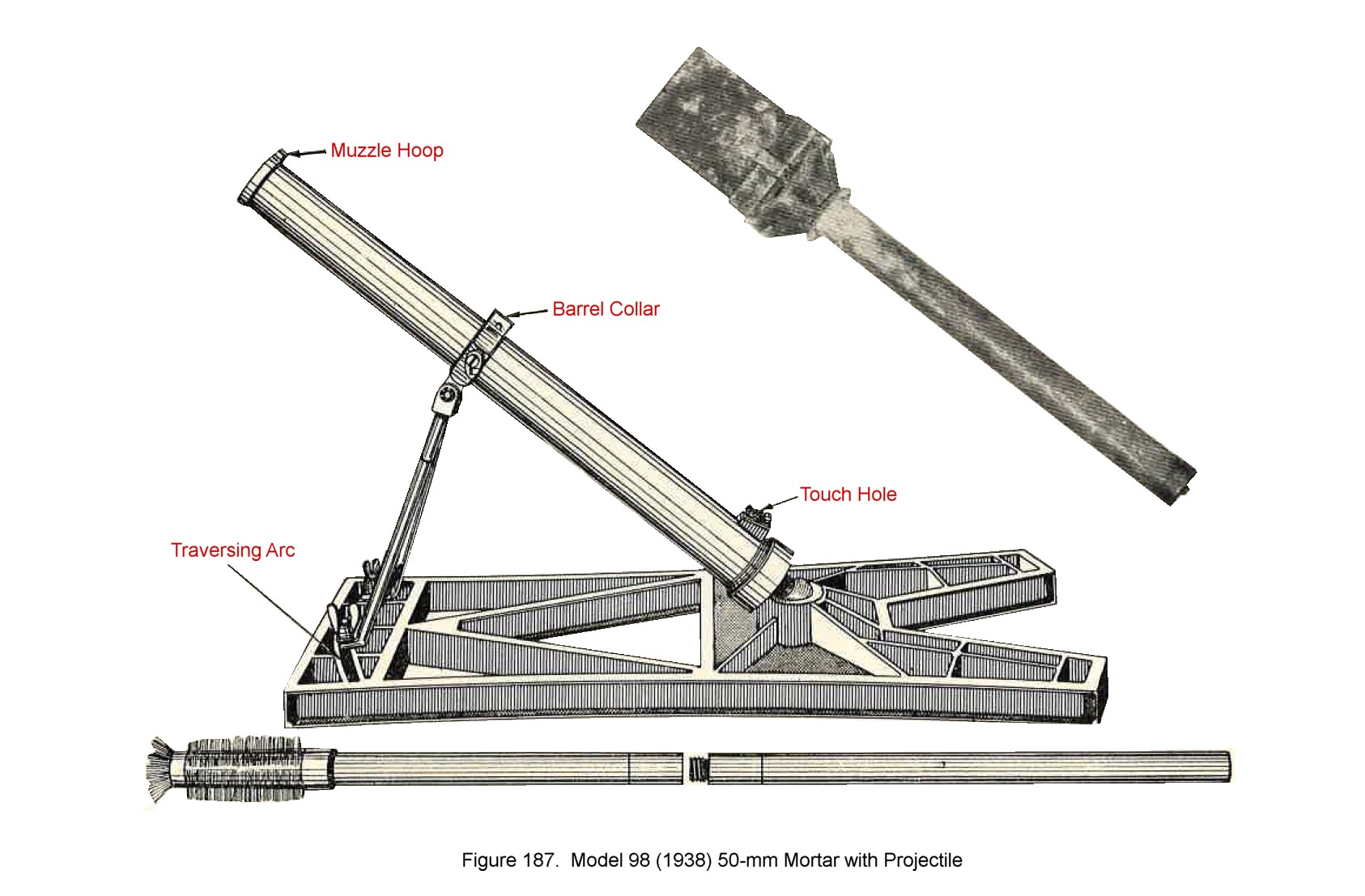 |
e. Model 11 (1922) 70-mm mortar.
(1) General description. This is an obsolescebt muzzle loaded, rifle-bore weapon (figure 188). The barrel is supported by a single elevating screw. The markings on the breech end of the barrel
 read "11th year model high
angle infantry gun". The latch pin on the breech end of the barrel must be set in to release the safety device. The weapon is fired
by means of a lanyard attached to the striker arm.
read "11th year model high
angle infantry gun". The latch pin on the breech end of the barrel must be set in to release the safety device. The weapon is fired
by means of a lanyard attached to the striker arm.
(2) Characteristics.
(3) Ammunition. The high explosive shell has the propellant powder in its base and operates in the same manner as the Model 89 grenade discharger shell prevously described. |
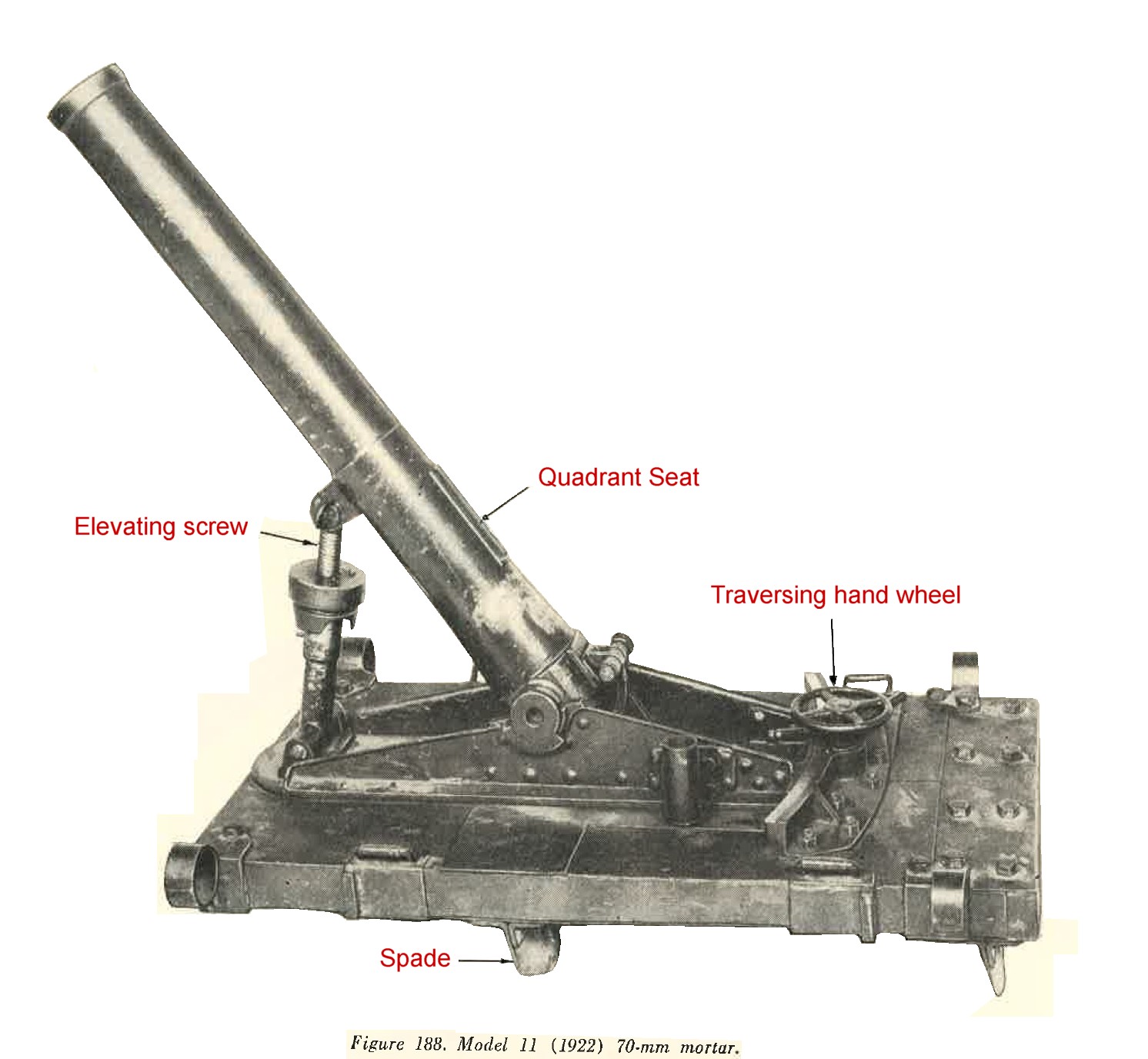 |
f. 70-mm barrage mortar.
This is a smooth bore, muzzle loaded weapon of a very simple comstruction (figure 189). It fires a shell probably designed for use against low flying aircraft (figure 189), or firing over the heads of ground troops. When fired, the projectile reaches a range of 3,000 to 4,000 feet when it expels a parachute-supported high explosive charges 11/16 inch in diameter and 3 inches long which in turn explode in the air. If an unexploded shell be found on the ground, it should be marked "Dangerous" and left for disposal by trained personnel.
 |
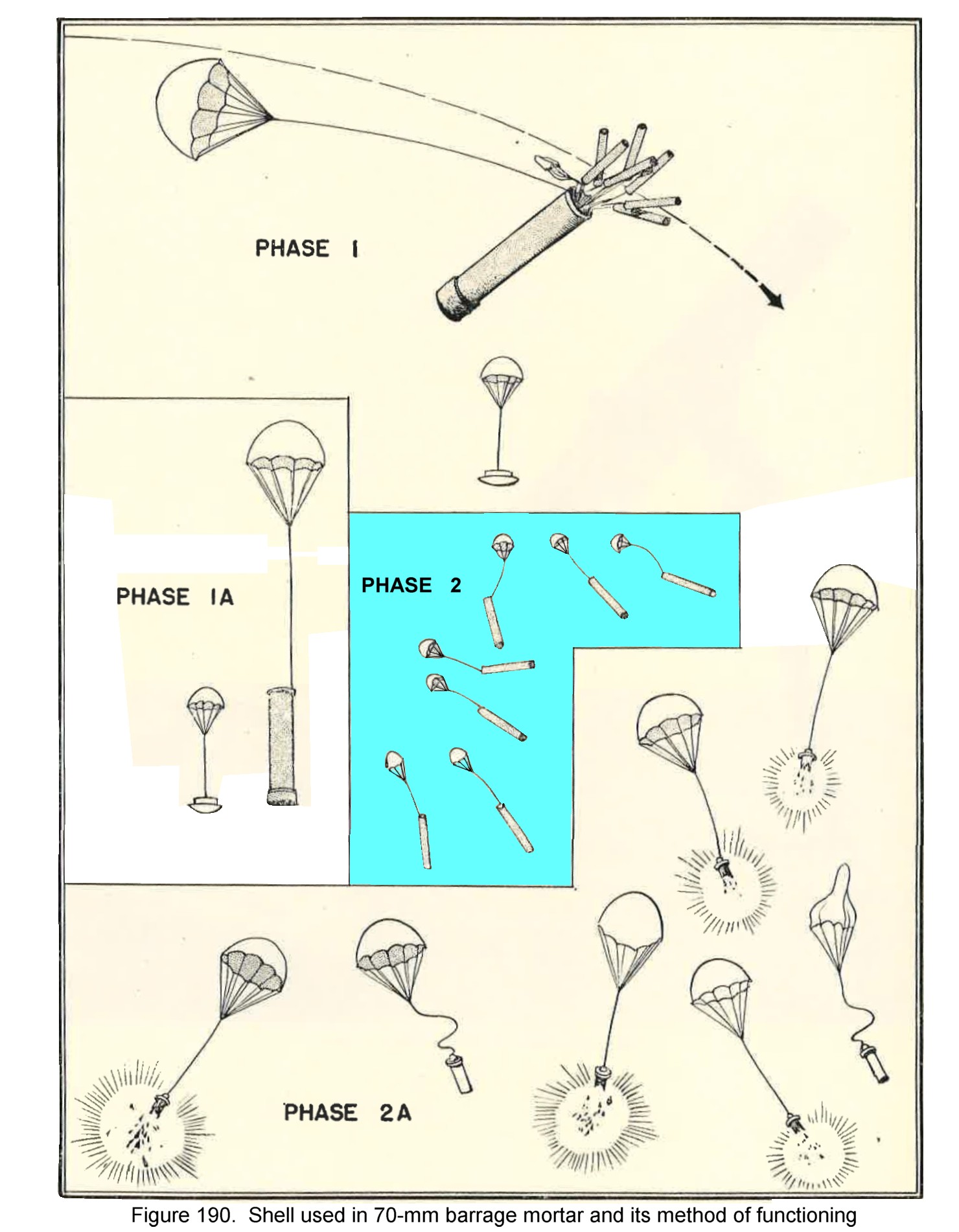 |
g. Model 97 (1937) 81-mm mortar.
(1) General description. This weapon is very similar to United States 81-mm mortar M1. It is a smooth bore, muzzle loading, high angle fire weapon (figure 191) which breaks down into 3 sections for transport. The markings
 which appear on the base
of the barrel read "97 model small trench mortar". The mortar is provided with a collimator sight which is heavier and more complex than the
U.S. M1 sight.
which appear on the base
of the barrel read "97 model small trench mortar". The mortar is provided with a collimator sight which is heavier and more complex than the
U.S. M1 sight.
(2) Characteristics.
|
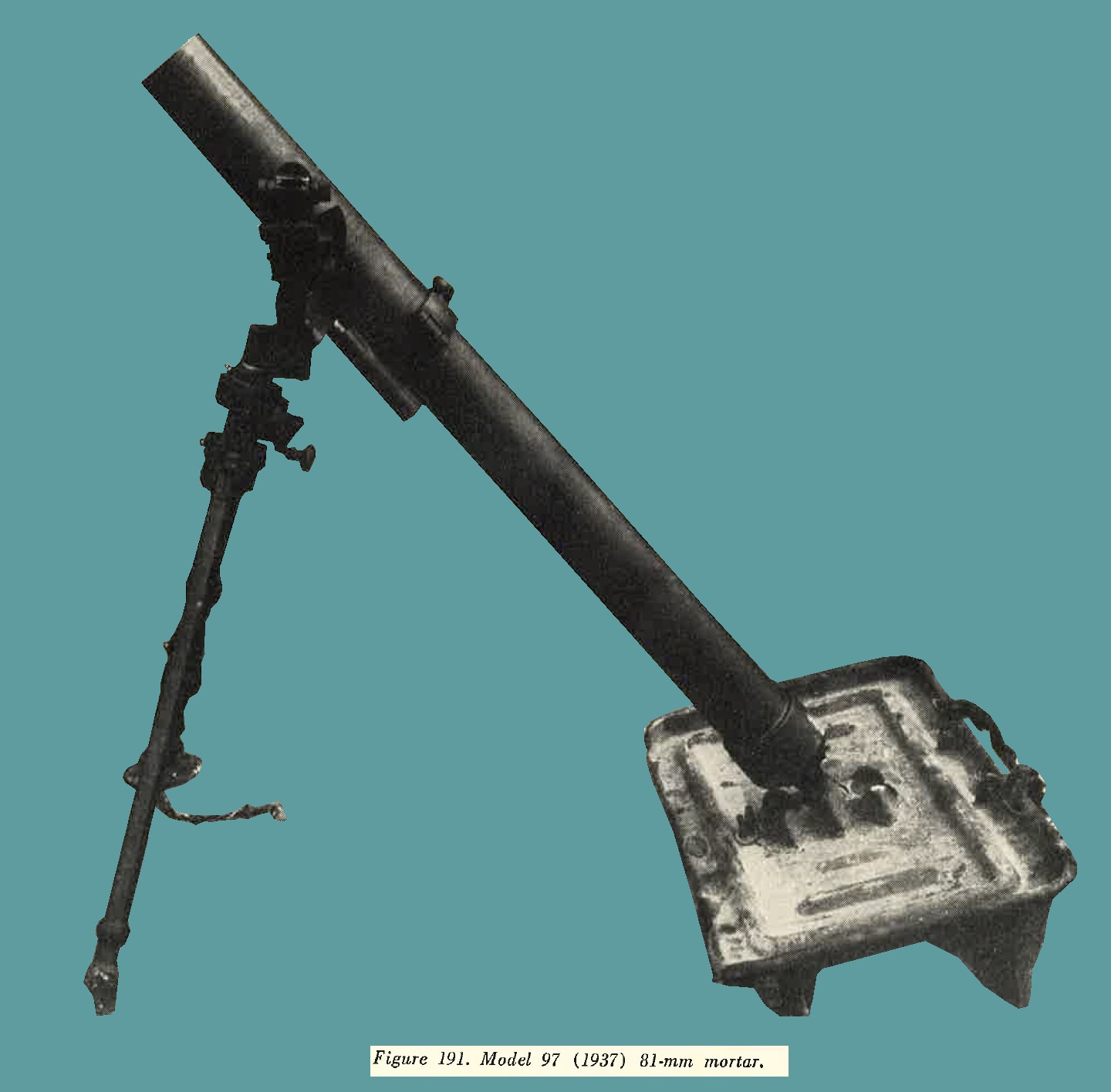 |
(3) Ammunition. This weapon fires high explosive shells which are interchangable with the United States M43 81-mm light shell. Heavier shells have been reported but no specimens have been recovered. The fuzes can be adjusted to give instanteneous or delay action detonations.
h. Model 98 (1939) 81-mm mortar.
(1) General description. Model 99 is similar to Model 97 except that it has a much shorter barrel and is equipped for trigger firing with a mechanism at base of the barrel (figure 192). For transport, this mortar breaks down into three sections, each weighing approximately 17 pounds. It may be fired with United States M43 81-mm mortar shells, in which case a maximum range of 2,500 yards may be obtained.
(2) Characteristics.
|
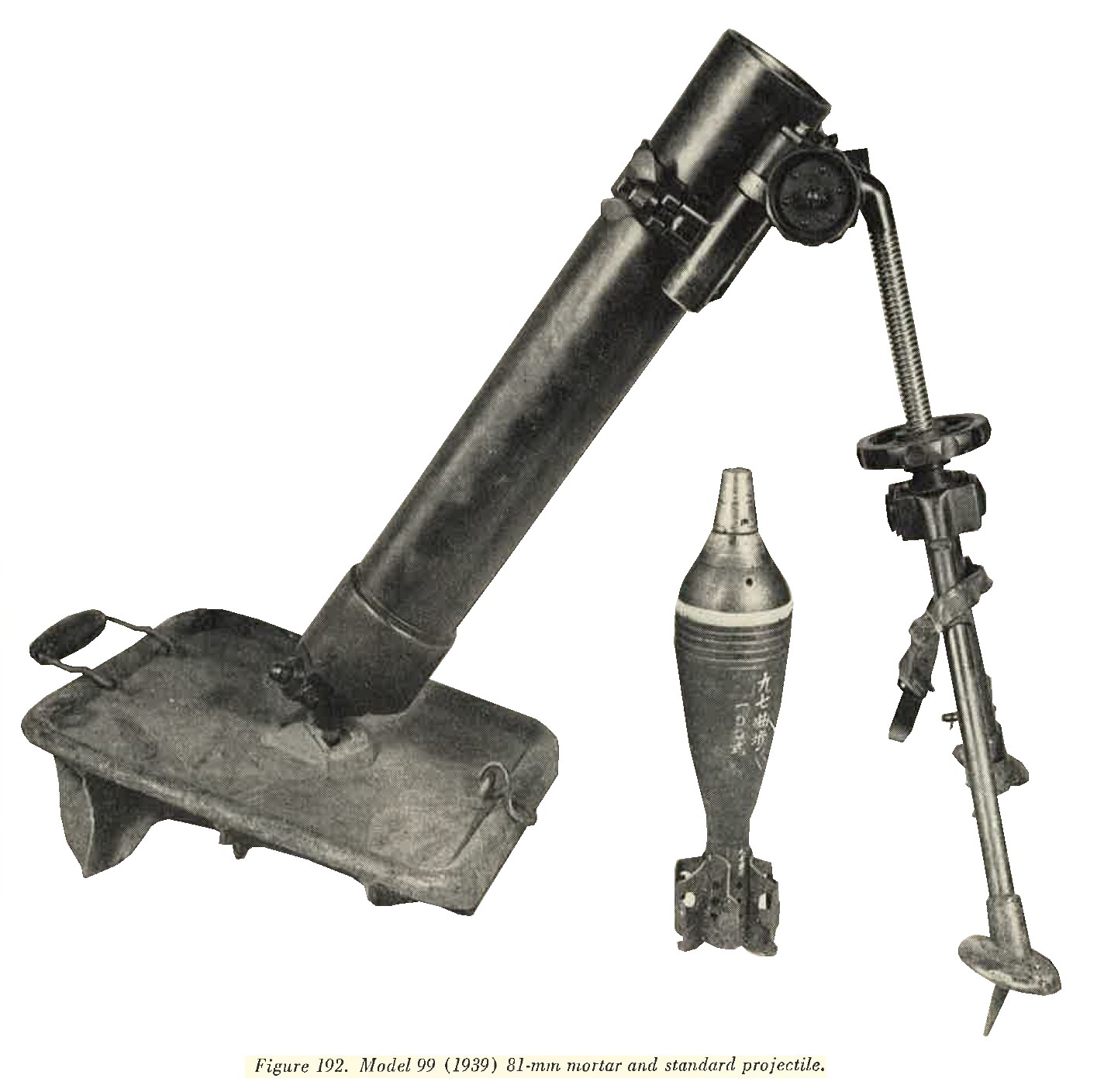 |
(3) Ammunition. HE and smoke or chemical shells have been recovered. The fuse may be adjusted for instantaneous or delay detonation.
i. Model 94 (1934) 90-mm mortar.
(1) General description. This is a smooth bore, muzzle loading weapon with a fixed firing pin (figure 193). A special feature is the recoil system, consisting of two recoil cylinders on one U shaped frame with cylinders located on each side of the barrel. The japanese markings on the base of the barrel
 read "94 Model light trench mortar".
read "94 Model light trench mortar".
(2) Characteristics.
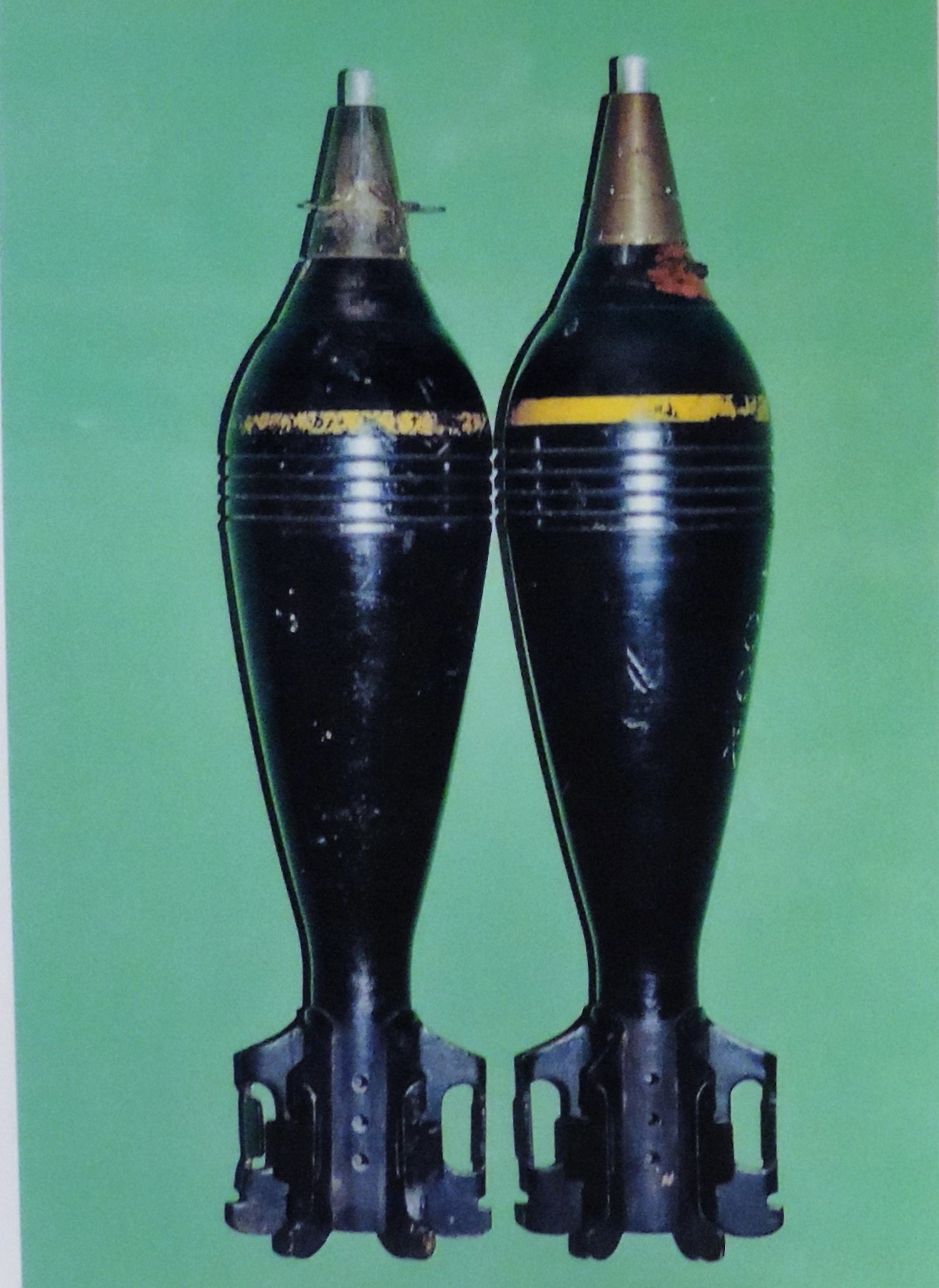
Figure 193-a. WWII Japanese High Explosive 90-mm mortar rounds. |
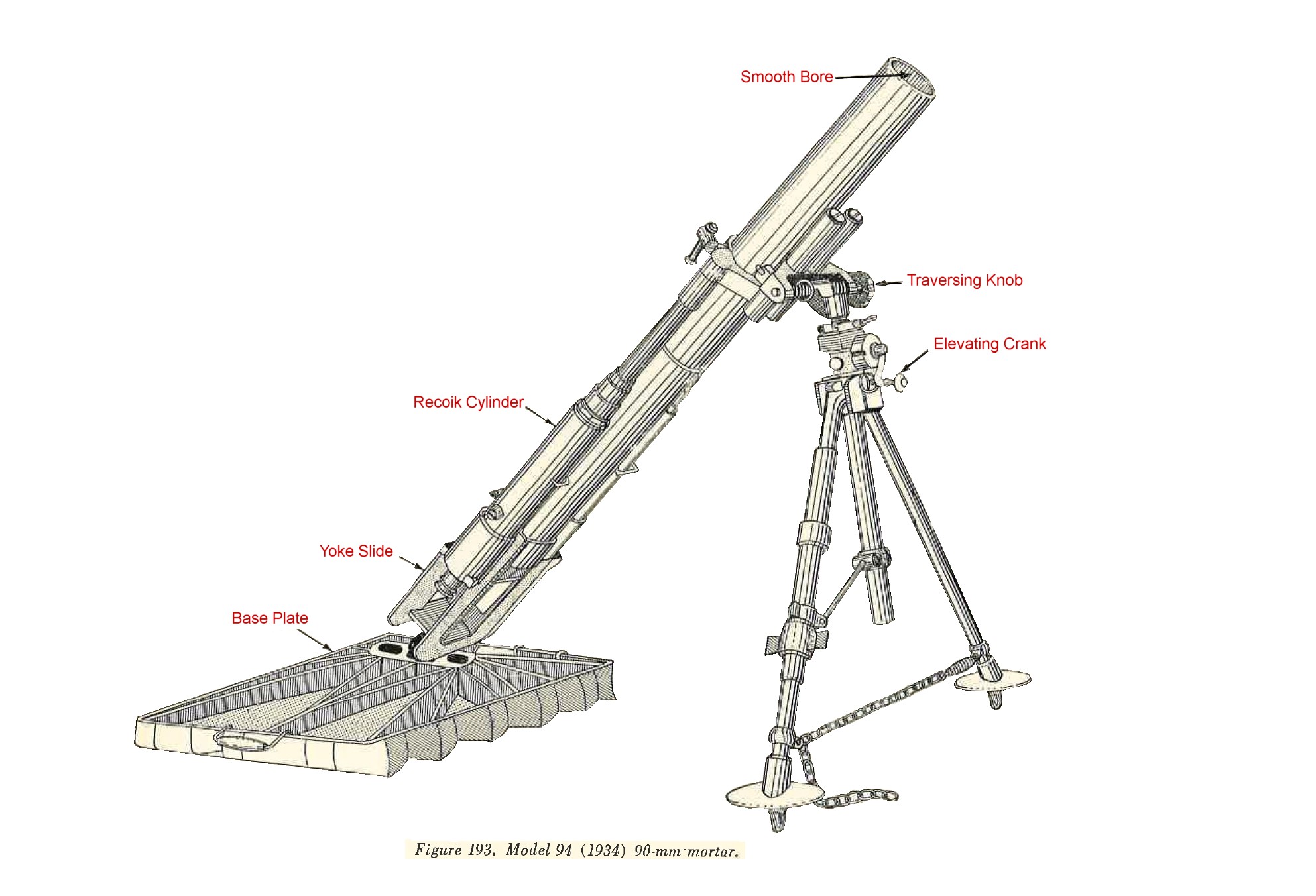 |
(3) Ammunition. Model 94 mortar fires HE and incendiary ammunition. The incendiary shell is 16 inches long, weighs 11.5 pounds. The mixture is white phosphorus, carbon disulphide and 40 impregnated rubber pellets. This shell can be identified by a red band below the fuse, a blue band between the fuze and bourrelet, a yello wband between the bourrelt and fin, and a white band at the junction of the shell and body and the fin. The fuze may be adjusted to give either instantaneous or delayed detonation.
j. Model 93 (1933) 150-mm mortar.
(1) General description. The photograph (figure 194) shown is believd to be that of the Model 93 (1933) 150-mm mortar, a smooth bore, muzzle loaded, lanyard fired weapon.
(2) Characteristics.
|
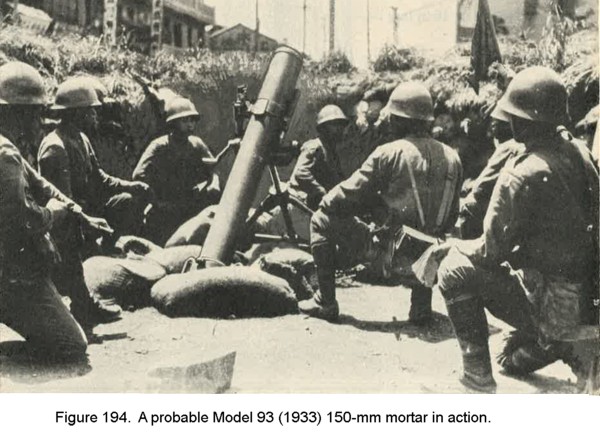 |
(3) Ammunition. Projected reported as weighing (total) 56 pounds and containing approximately 14 pounds of explosive.
4. WWII JAPANESE GRENADES, LAND MINES, AND BOOBY TRAPS.
a. General. The following section provide a general picture of Japanese grenades and land mines. Certain of these items have been used in the construction of booby traps. The most common methods of making booby traps are covered here, However, there may have been other methods for manufacturing them.
b. Booby traps. Although the Japanese use of booby traps has been limited as compared to the Germans, ir is expected that these traps will be more and more frequently encountered as Allied forces push the Japanese from prepared positions. As many types of Japanese Ammunitions are suitable for employment as booby traps only the most common are listed.
 |
The Model 23 pull type fragmentation grenade is particularly suitable for this purpose when attached to doors, window frames, and general items of
abandoned equipment. In addition multiple reports have been received of captured allied grenades (i.e. British No. 36 and United States MK 2)
being similarly employed.
Although there is no evidence to date that the stick grenade, the bangalore torpedo, or explosive canister from the barrage mortar shell have been used as booby traps, the fact that all have pulled igniters and accidents have occurred to troops handling them, prove that they are most suitable for such. The 3 types of fragmentation grenade models 91, 97 and 99 ("Kiska") grenade are equipped with percussion ignited fuses. They have been used with a suspension wire device which can be tripped. The grenade is placed bottom up inside an improvised tube this ensuring that the grenade will fall head first so as to detonate the fuse, when a wire is tripped (see figure 195). A piece of bamboo or empty cartridge case is sometimes used in lieu of a tube. |
|
Another and less elaborate variation is found in the use of the above listed grenades under foot board. The weight of the foot fires the detonator
instantenously.
many of the land mines have been used as booby traps and work on the same principle, Model 93 being equipped so that it can be activated by pressure from 7 to 200 pounds. Only one or two electrically operated booby traps have been encountered so far. they operate on a low voltage and are generally attached to equipment such as radios and vehicle ignition switches. It can be expected that booby trap fuzes of more advanced design, will probably appear in the near future, as the Japanese are driven back. 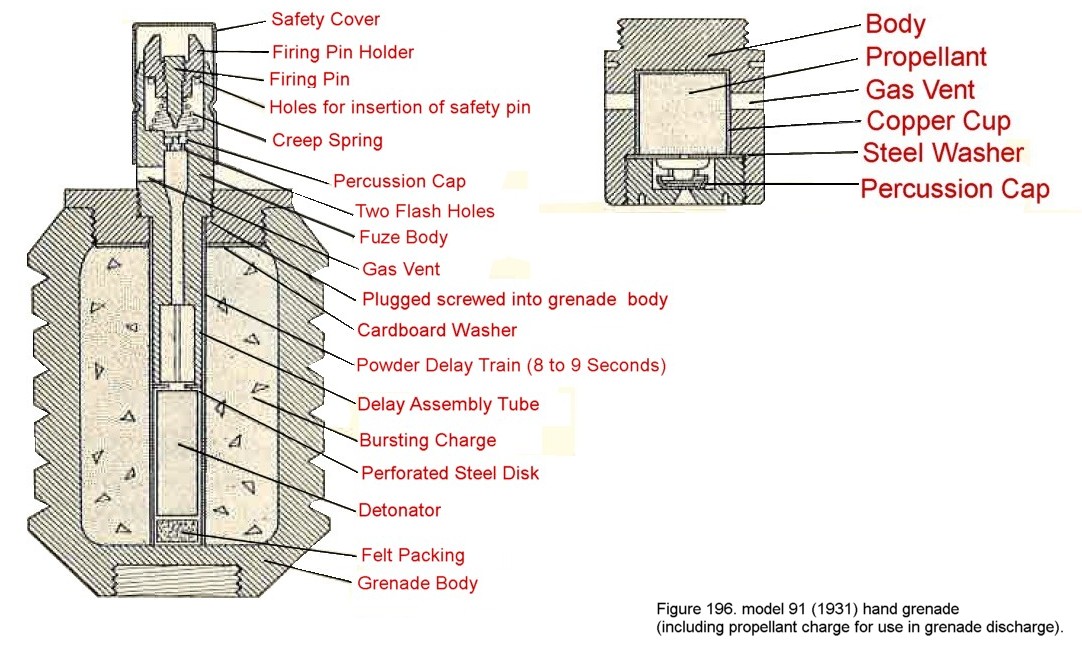
|
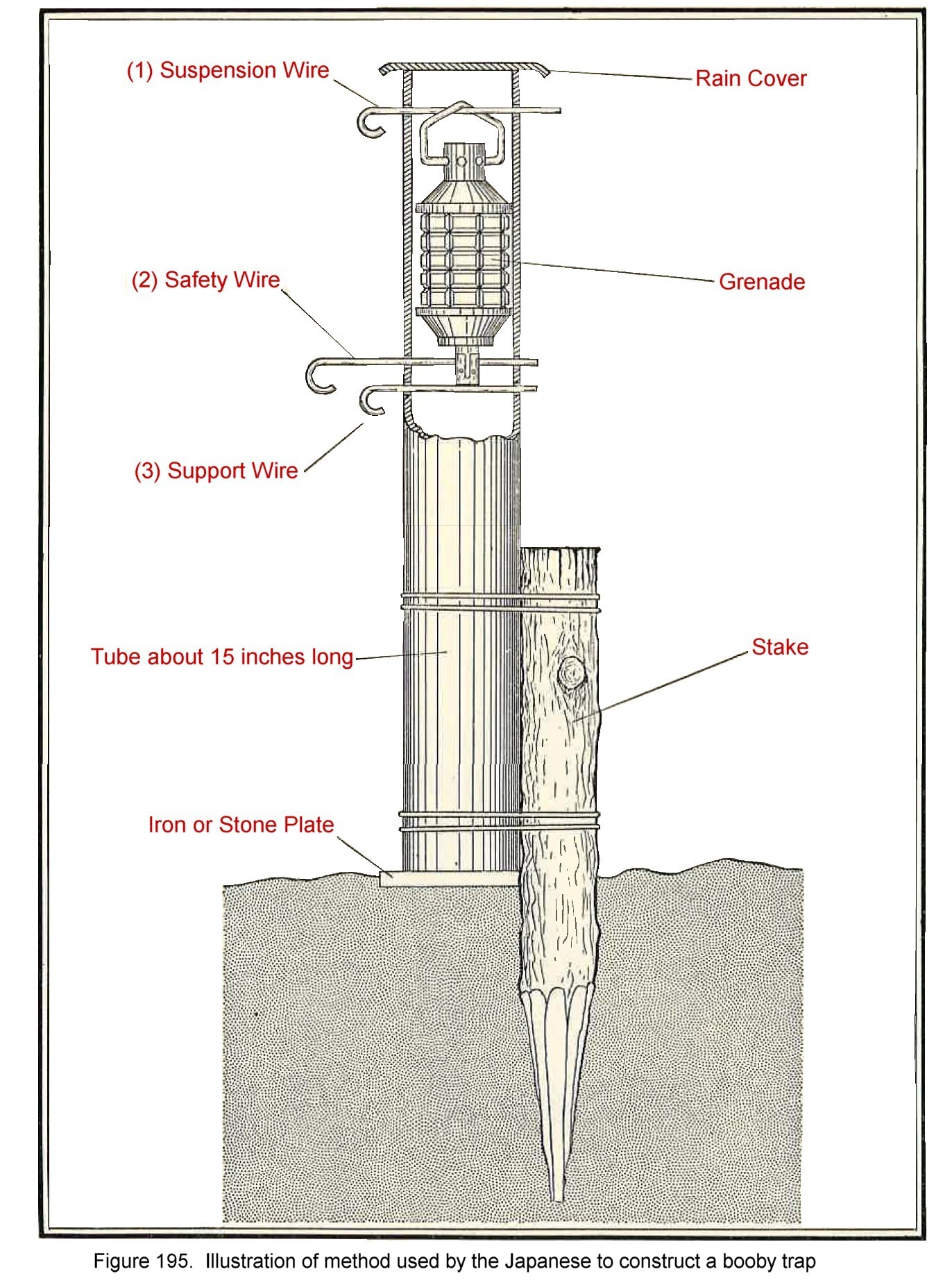 |
c. Model 91 (1931) hand grenade.
(1) General description. Model 91 (1931) fragmentation grenade (figure 196) can be thrown by hand, fired either from Models 10 or 89 grenade dischargers, or fired from a rifle grenade launcher (discharger) with tail assembly added. The base constains a primer and propelling charge for use when firing from a grenade discharger.
(2) Characteristics.
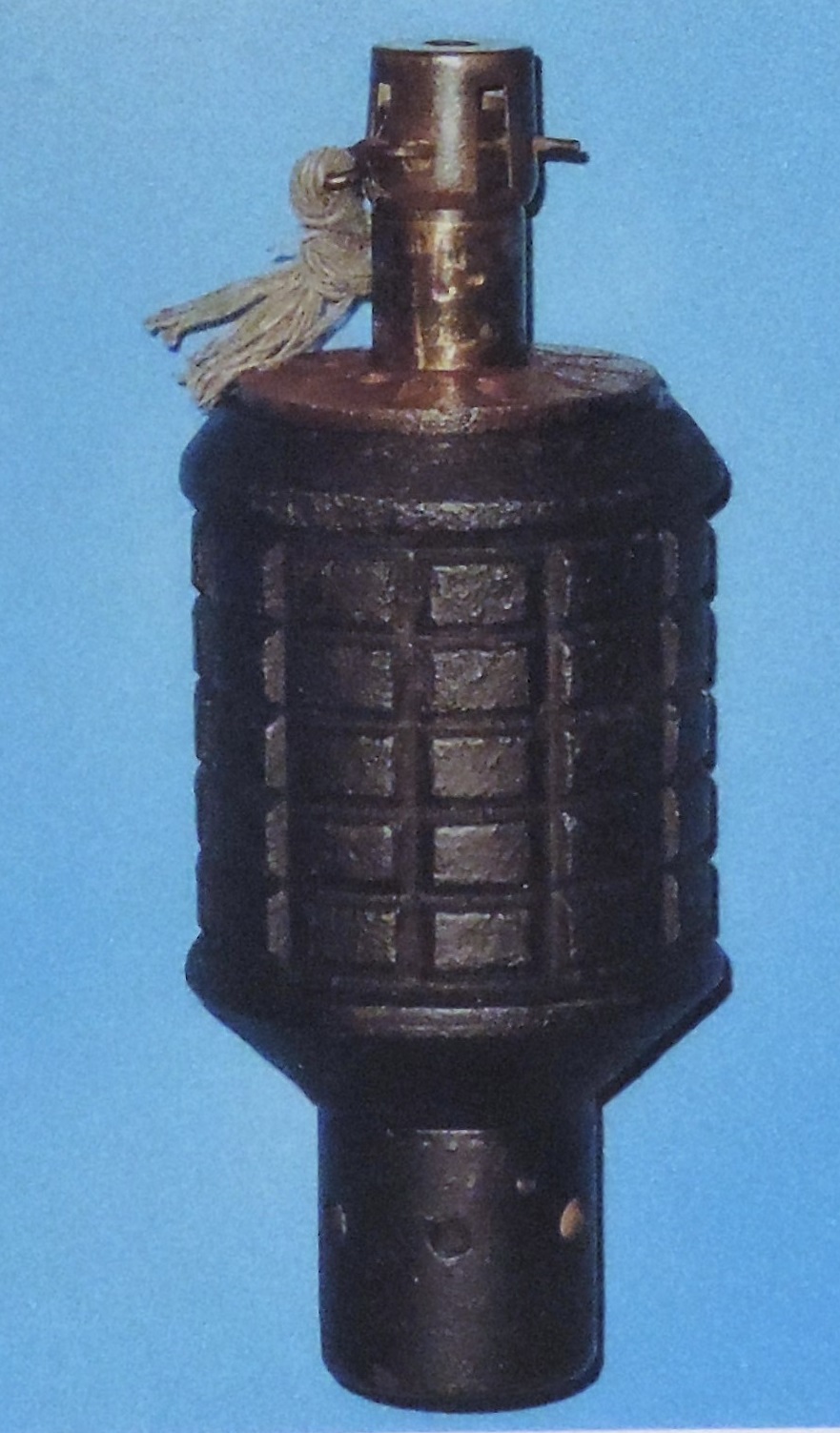
Figure 196-a. WWII Japanese Model 91-mm hand grenade (knee mortar/rifle/hand). (3) Operation. (a) To arm. With safety screw in position, screw firing pin down into firing pin holder, with screw driver or knife blade, as far as it will go. (b) To use as hand grenade. Hold grenade with fuze pointing downward, remove safety pin, making sure that safety cover does not fall off. Strike head of fuze against solid object such as helmet keeping hands clear of the gas vent hole. Throw immediately since action of fuze is sometimes erratic. (c) To use in grenade discharger. Remove safety pin and drop into discharger. |
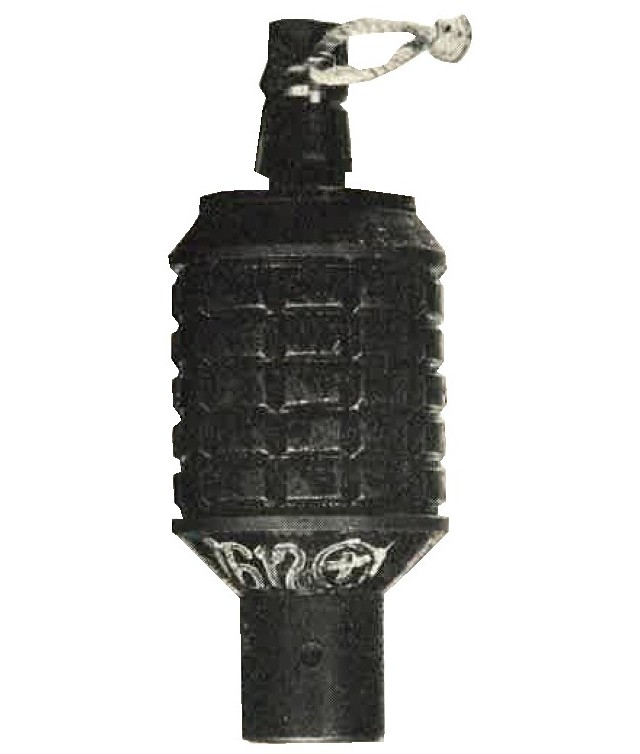 |
d. Model 97 (1937) hand grenade.
(1) General description. The Model 97 (1937) fragmentation hand grenade (figure 197) is carried by all front line troops and is almost identical with Model 91, except hat it has no provision for a base propellant attachment and has a shorter fuze delay time. It cannot be fired from a grenade discharger.
(2) Characteristics.
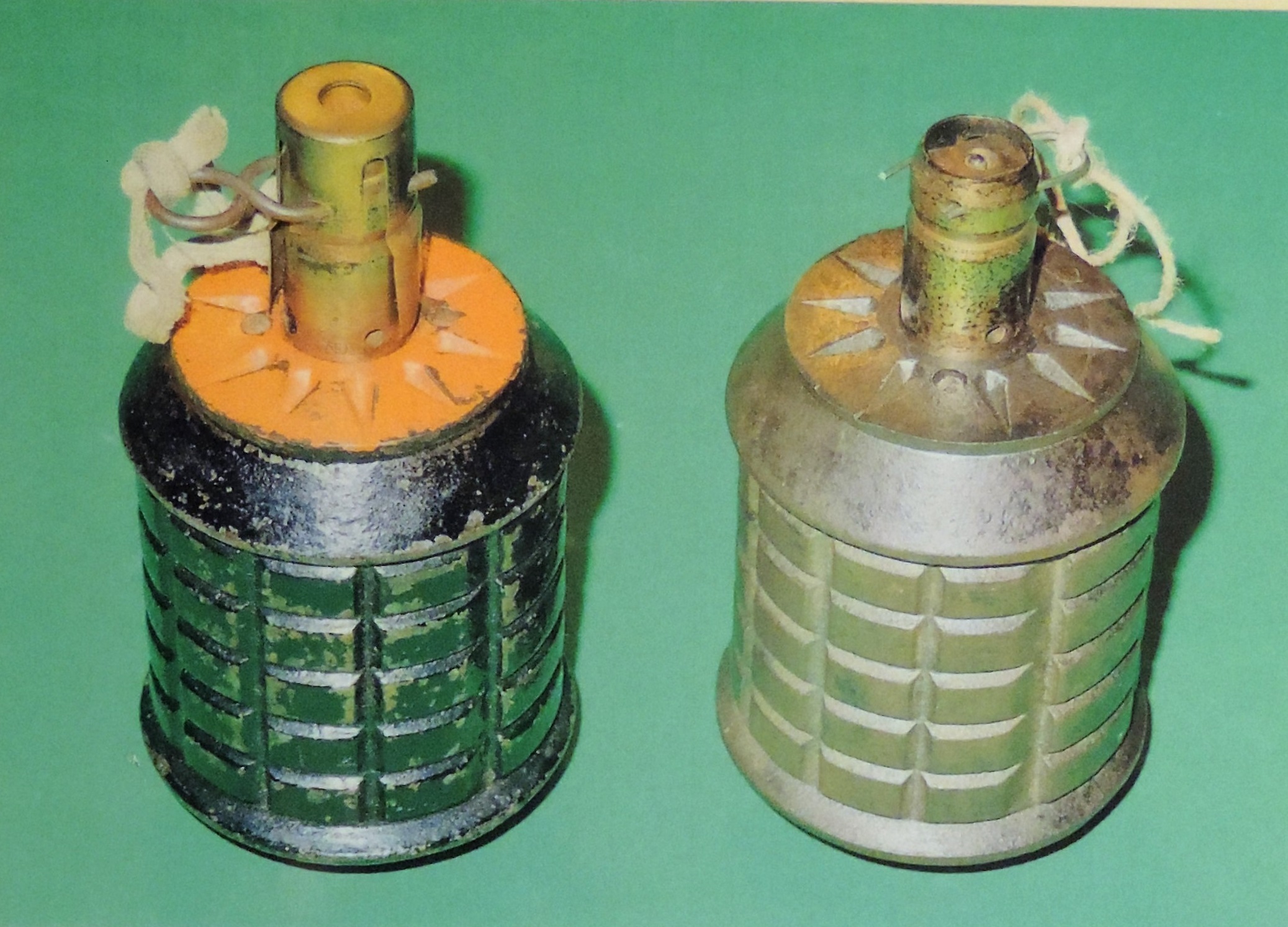
Figure 197-a. WWII Japanese Type 97 hand grenades. |
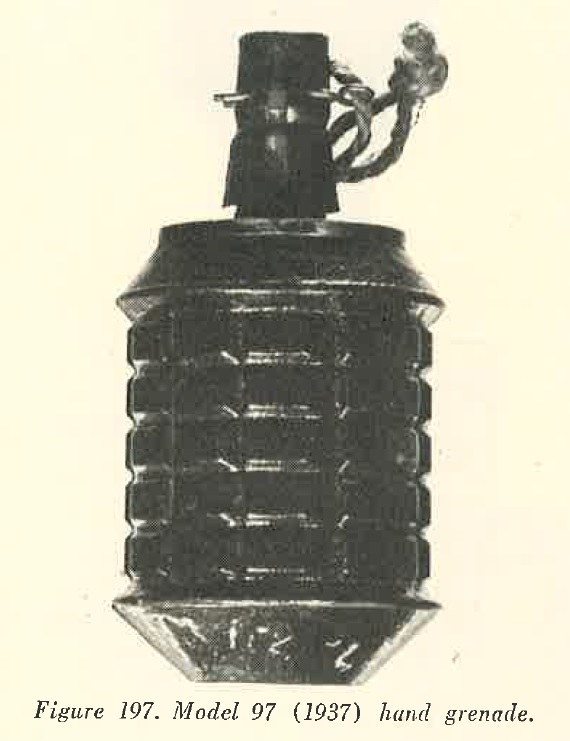 |
(3) Operation.
(a) To arm. With safety pin in position, screw firing pin down into firing pin holder as far as it will go.
(b) To throw. Hold grenade with fuze pointing downward. Remove safety pin, being sure that safety cover does not fall off.Strike head of fuze against solid object such as helmet keeping hands clear of the gas vent hole. Throw immediately since action of fuze is sometimes erratic.
e. Model 99 (1939) hand grenade.
(1) General description. This grenade has been identified as Model 99 (figure 198). It is smaller than the Model 97 and 91 fragmentation grenades and unlike these, it has a smooth cylindrical body with a flange at either end. It may be ;aunched from a special launcher mentioned previously under Section "Rifle grenade launchers" (figures 176 and 177).
(2) Characteristics.
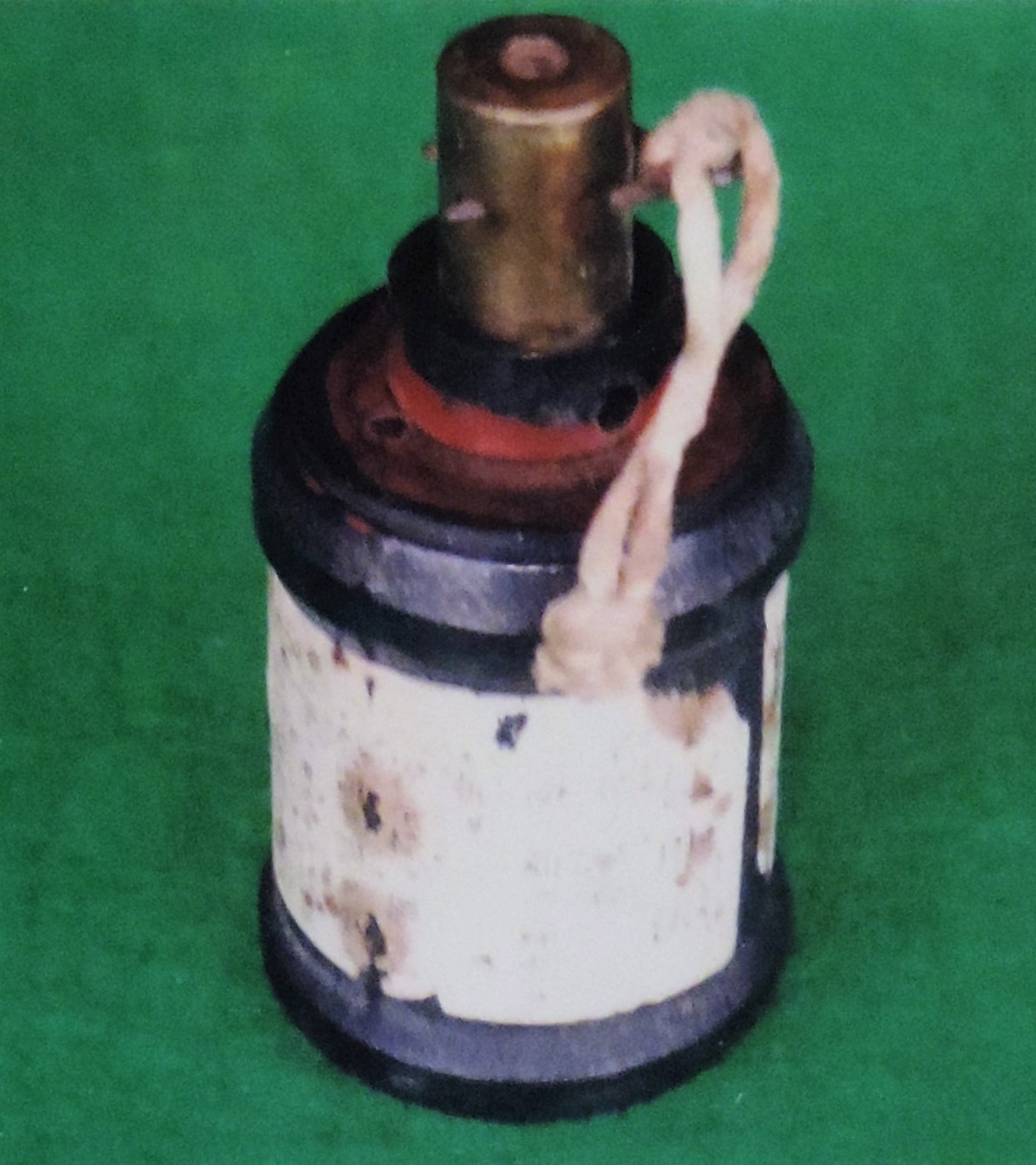
Figure 198-a. WWII Japanese Model 99 hand grenade. |
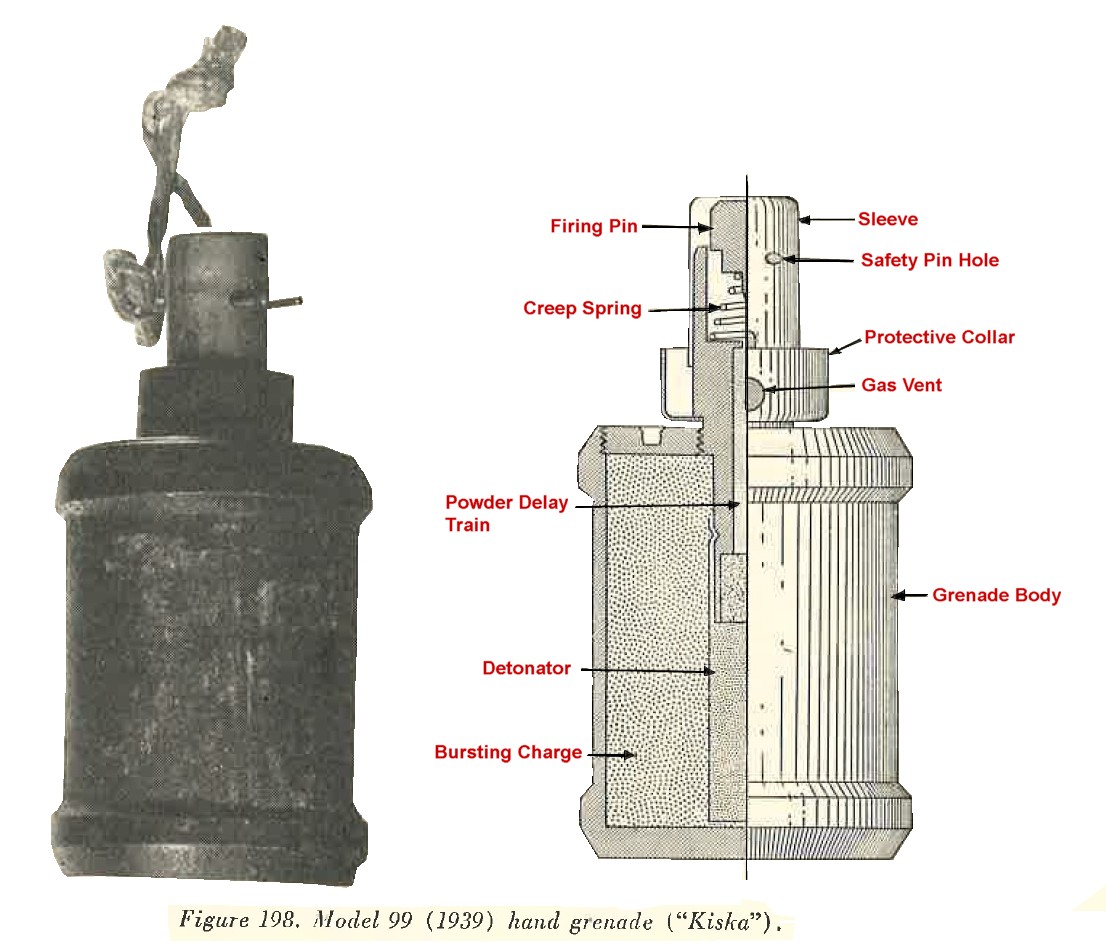 |
(3) Operation.
(a) To arm. Remove safety pin which is held in place by a cord.
(b) To use as a hand grenade. Strike the head of the fuze on a hard object and throw immediately. Since the firing pin is integral with the firing pin holder no screwing or unscrewing is necessary, as with Models 91 and 97 fragmentation grenades. It can be used as a booby trap by removing the safety pin and setting under a floor board or chair.
(4) Alternative fuze. It is believed that there is a variation of this grenade knwon as the Model 99B, which is activated by a friction igniter fuze.
f. Model 23 grenade.
(1) General description. This grenade (Figure 199) appears to have been appears to have been designed to use either as a hand grenade or a booby trap. It has a pull type friction igniter fuze with a time delay reported as approximately 5 seconds. Because a pull (from 2 1/2 pounds to 5 pounds) on the fuze cord ignites the time fuze, it could easily be adapted for use as a booby trap by tying the cord to a trip wire. The lugs and rings on the side are convenient for anchoring the grenade in place when so used. It has also been found in a booby trap with a high explosive artillery shell tied to it for augmenting the power of the explosion.
(2) Characteristics.
|
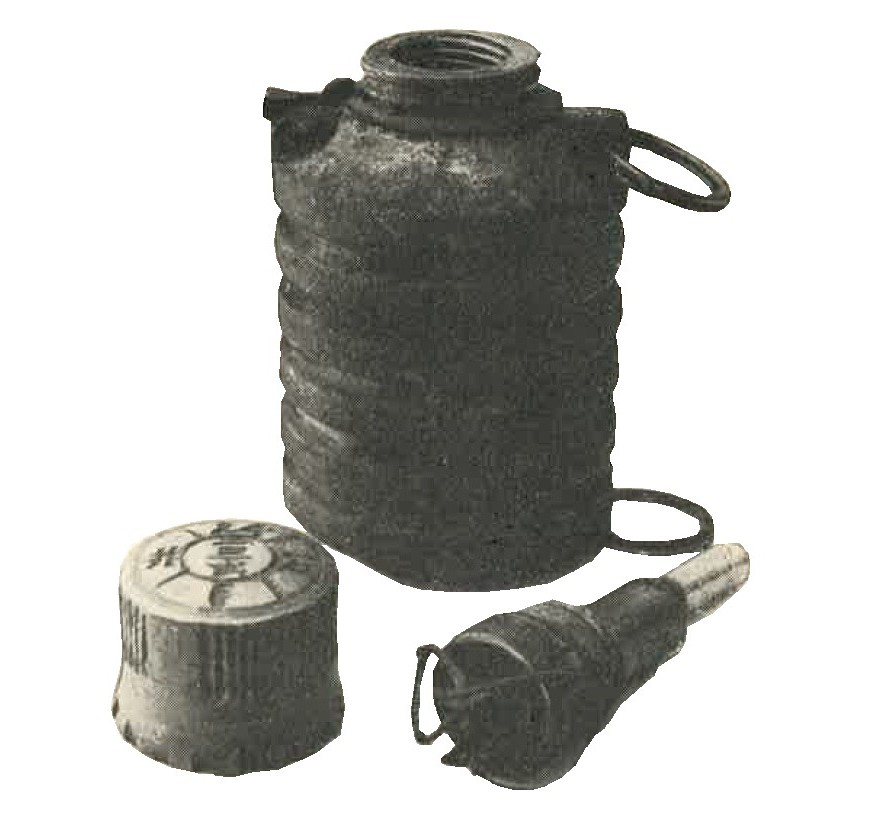
Figure 199. Model 23 hand grenade. |
g. 1/2 kg. Grenade.
5.3 inches long and weighing 1.1 pounds (approximately), it may be thrown by hand or projected from the grenade discharger Model 89. Incindiary filling is White phosphorus.
h. Incendiary stick grenade.
(1) General description. The body of this grenade (figure 200) is filled with impregnated rubber pellets in a phosphorus carbon disulphide solution. There are some 40 pelletts in each grenade, which are scattered by a central busting charge. It is also possible that this grenade is sometimes filled with phosphorus smoke contents. (2) Characteristics.
| The grenade is 13.s inches long and the body has a diameter of 2.1 inches. The handle is made of wood. |
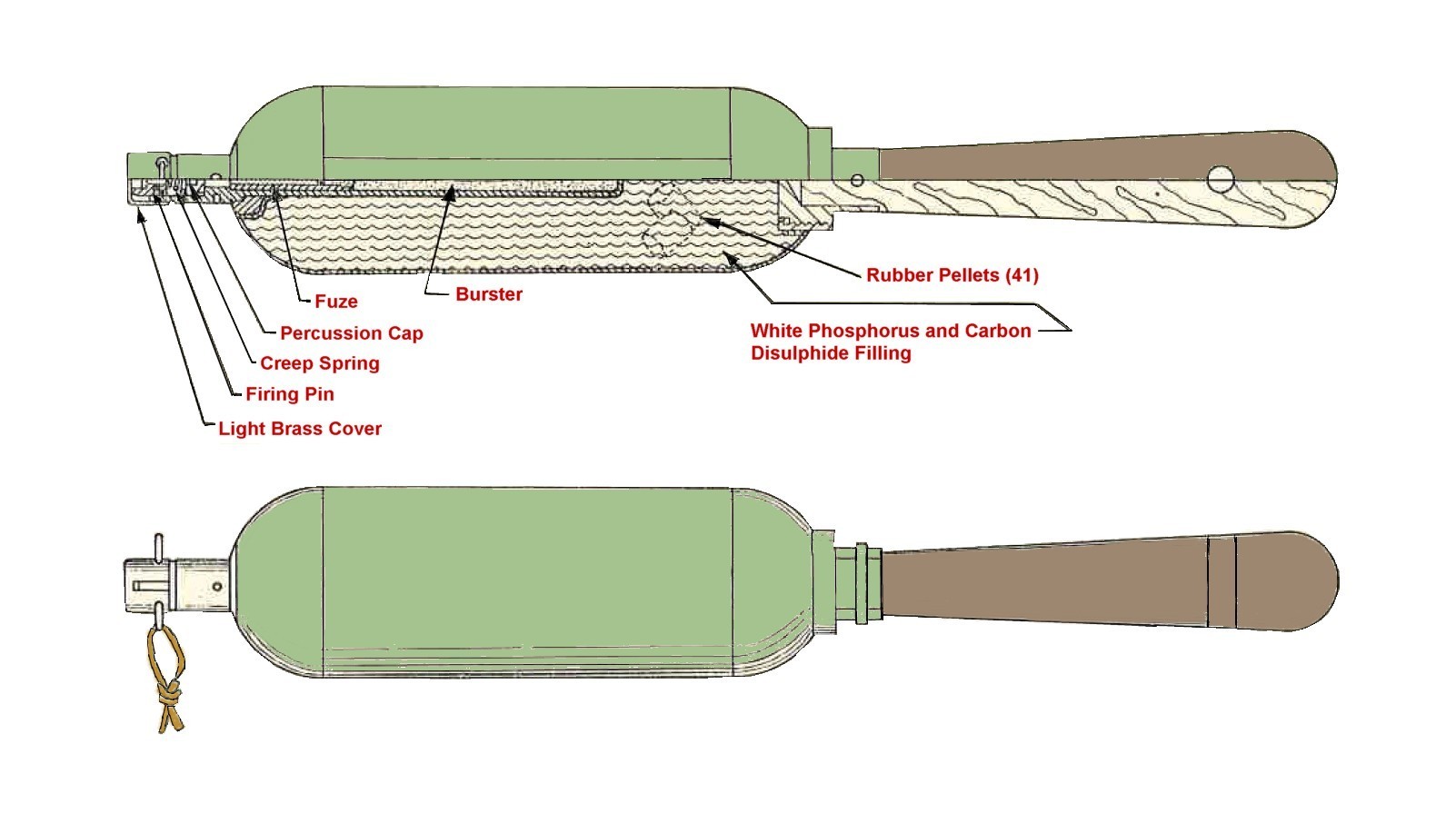
Figure 200. Incendiary stick hand grenade. |
(2) Operation.
(a) To arm. Make sure that the safety pin is in position and that the firing pin is threaded down into the firing pin holder.
(b) To throw. With the fuze pointnig downward. Withdraw the safety pin. Making sure that the safety cover does not fall off, strike the head of the fuze against some hard object, such as the heel of your shoe or the top of your helmet. There should be no delay in throwing the grenade, since actual fuze delay time is not known.
i. High explosive stick hand grenade.
(1) General description. This is the well known "potato masher" type of grenade with a pressed metal cap at the end of the handle (figure 201). It has a smooth cylindrical body.
(2) Characteristics.
|
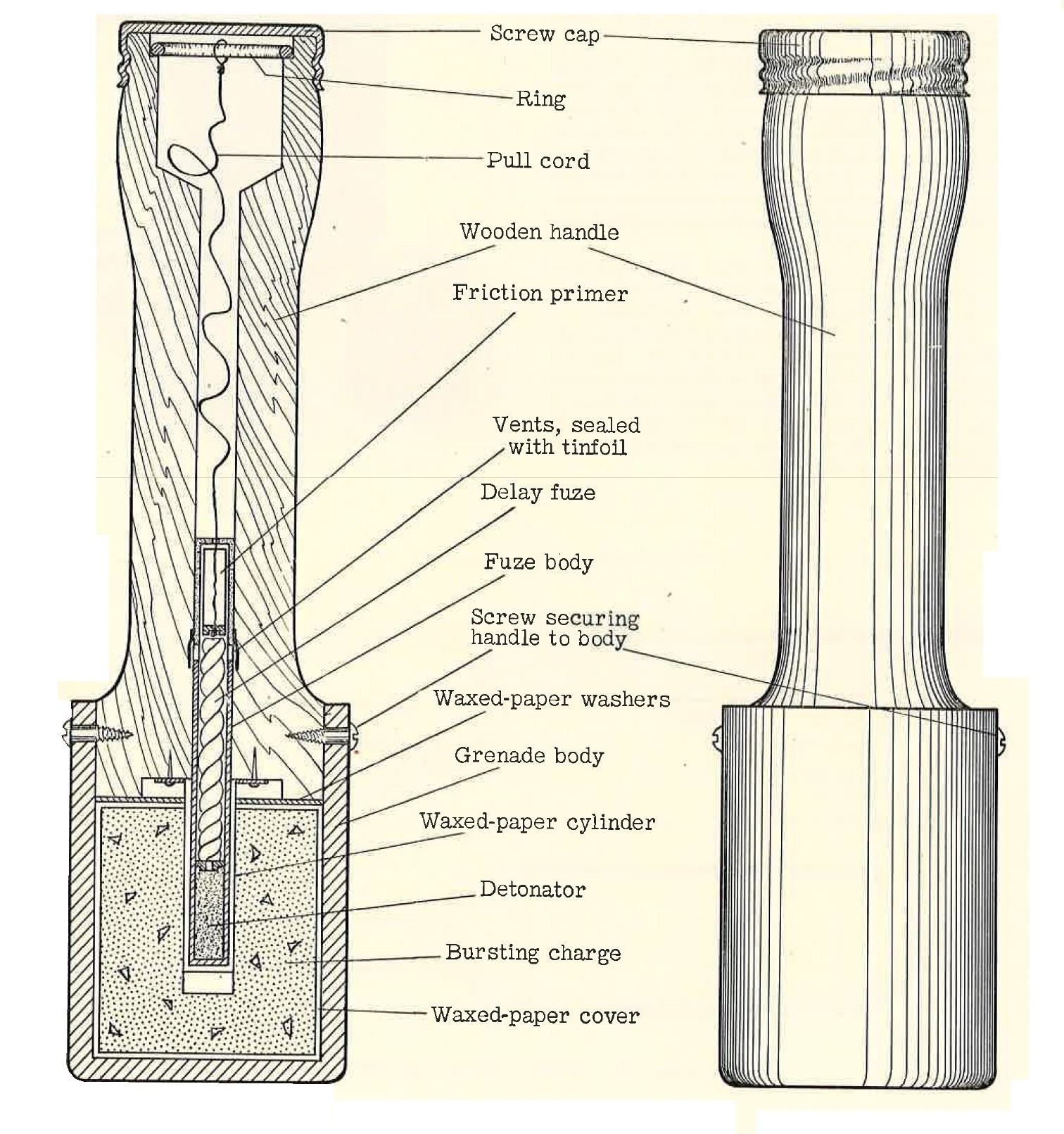
Figure 201. WWII Japanese high explosive stick hand grenade. |
(3) Operation. Remove the metal cap. a ring with a string attached will be found. This ring is slipped on the finger and the grenade thrown. The string pulls away from the grenade and starts the time fuze burning. This grenade can be used as a booby trap by attaching one end of a trip wire to the ring and the other end to a moveable object such as a door, helmet, etc.
j. Molotov cocktail incendiary grenade.
(1) General description. This is a Japanese version of the "Molotov Cocktail". It consists of a standard bottle (Figure 202) filled with a mixture of oil and gasoline. (The bottle illustrated in figure 202 is a Japanese beer bottle.) The fuze is an "all-ways" type that will ignite when the grenade is thrown no matter in what position the bottle lands, for the impact drives the firing pin down into the detonator which ignites the contents of the bottle.
|
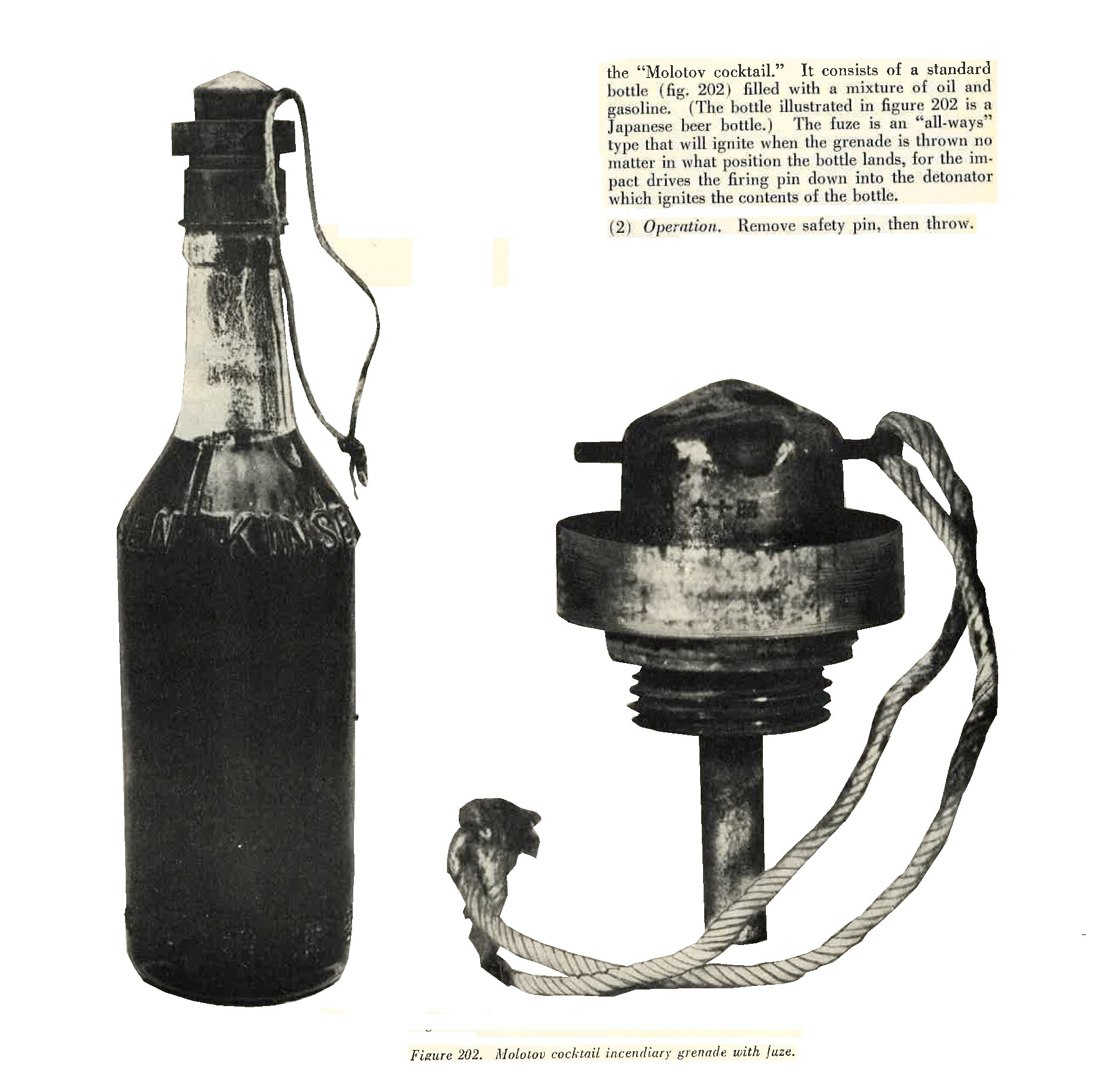
Figure 202. WWII Japanese Molotov cocktail incendiary grenade with fuze. |
k. Frangible smoke grende white.
Speherical, flat bottom glass flask 3 inches in diameter and filled with a yellowish liquid varying from 100 percent titanium tetrachloride to a mixture of approximately 60 percent titanium tetrachloride adn 40 percent silicon tetrachloride. The grenade (figure 203), is packed in sawdust in a cylindrical sheet metal container.
|
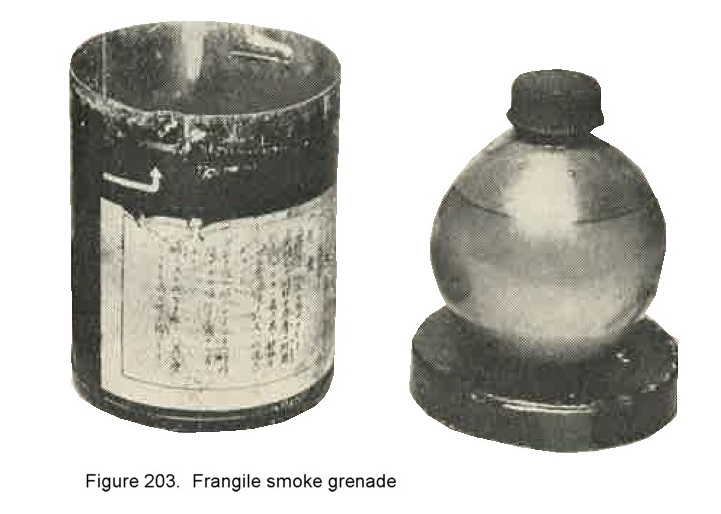 |
l. Frangible Hydrocyanic Acid (AC) grenades.
Two different types exist. One estabilized with copper powder and is packed in a sheet metal outer container, teh other is stabilized with arsenic trichloride and packed in a cardboard container. The grenade (figure 204) consists of a spherical glass flask about 3 1/2 inches in diametercontaining approximately 1 pint of hydrocyanic acid. The flask is packed in a mixture of sawdust and a neutralizing agent. The outer container is approximately 5 1/4 inches high and 5 1/2 inches in diameter, it is painted Khaki and banded in brown.
|
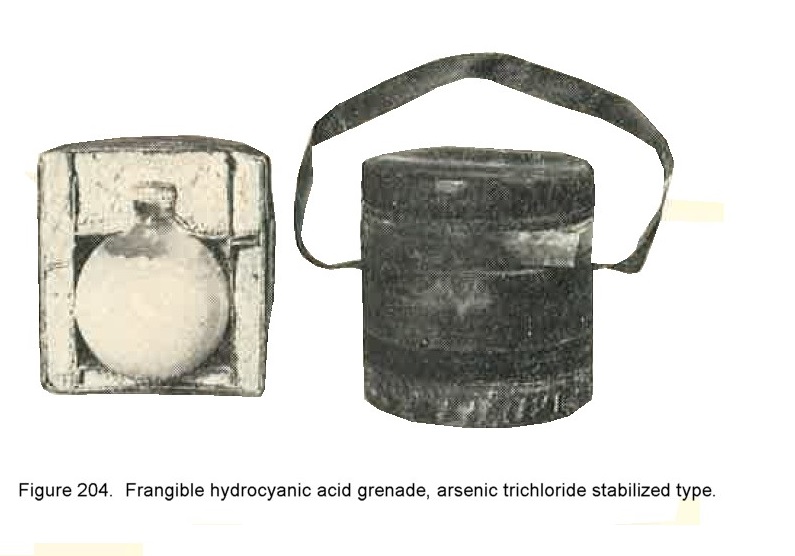 |
m. Bangalore torpedo.
(1) General description. This is the standard bangalore torpedo (Figure 205) for the Japanese army. It has a pull type delay fuze and is threaded at each end to permit an indefinite number of tubes to be attached end to end. Because of the type of fuze, it may be used as a booby trap with the igniter string tied to a trip wire.
(2) Characteristics.
|

Figure 205. Bangalore torpedo. |
(3) Operation.
(a) Remove plugs, screw together the selected number of tubes, remove the bullet shaped cap from fuze and place on one end. screw fuze in place. When ready to detonate the bangalore torpedo, pull the safety pin, and pull the lanyard (requires about a 13-pound pull). The fuze delay will be approximately 6 to 7 seconds.
(b) For additional information concerning Japanese bangalore torpedoes see hapter 10, Section V, paragraph 5b.
Note
Another bangalore type land mine which may be an antitank mine has been found. Its characteristics are as follows:
|
(b) For additional information concerning Japanese bangalore torpedos see Chapter 10, section V, paragraph 5b.

n. Model 93 (1933).
This mine (Figure 206) is exploded by pressure applied anywhere on the upper surface. It is used either for anti-personnel or antitank purposes. Fuzes are provided with shear wires of various strengths, so the fuzes may function under pressure of from 20 pounds to as much as 250 pounds depending on the fuze selected. Additional explosive may be placed under the mine to give it greater force.
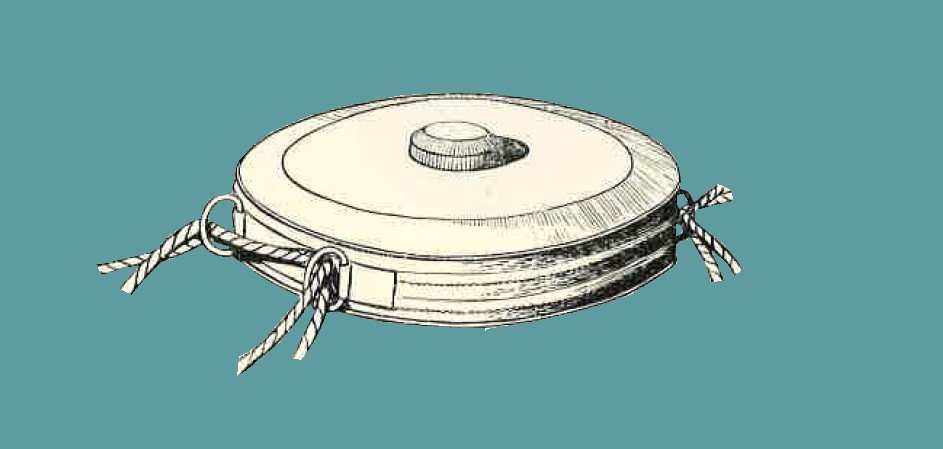
Figure 206. Model 93 (1933) mine.
o. Model 99 (1939) armor piercing mine (grenade).
(1) General description This mine (Figure 207) is issued to infantry units and is carried by the individual soldier. It is sometimes referred to as the "magnetic antitank bomb" or "armor piercing grenade". The magnets serve to hold the mine against a metal surface such as a tank (or iron pillbox door) unitil it explodes.
(2) Characteristics
|
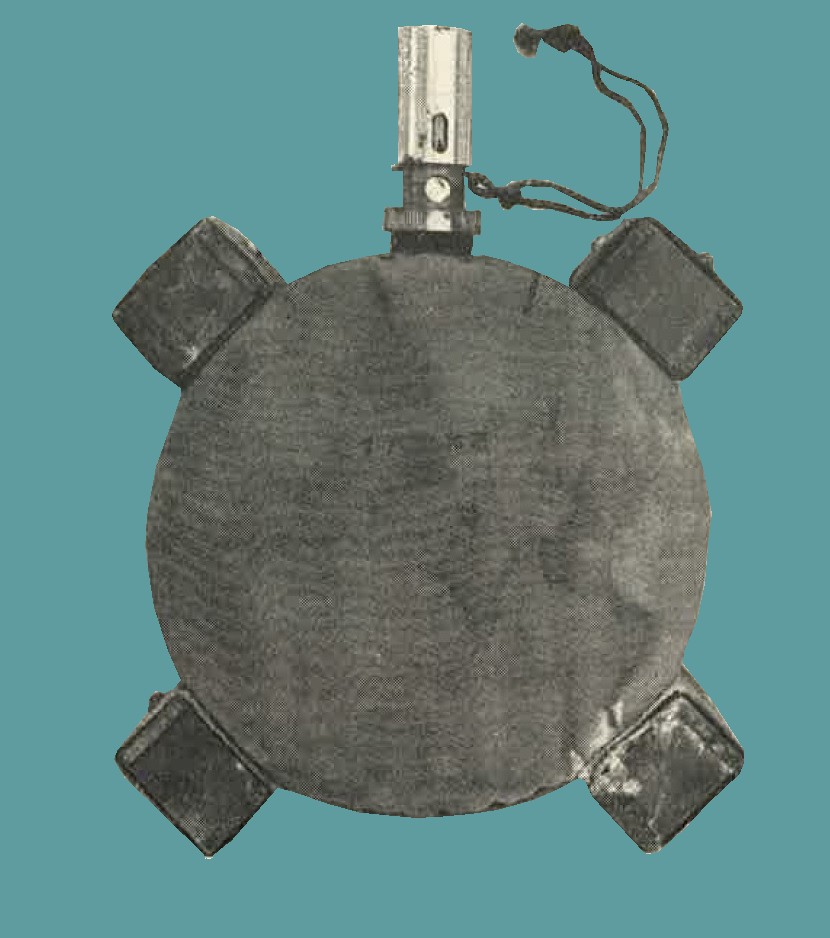
Figure 207. Model 99 (1939) armor piercing mine with fuze. |
(3) Operations Screw the fuze into the fuze hole. Remove safety pin. place by hand against object to be destroyed. Give the fuze cap a sharp blow. A time delay of approximately 5 to 6 seconds gives a man time to withdraw. It has been claimed that the mine can be thrown against the target rather than having to be placed there by hand.
p. Model 96 (1936) mine.
(1) General description. This is a large, very powerful mine (Figure 208) adapted for use either on land or under water. The two lead alloy horns enclose glass vials containing an electrolytic fluid. Pressure on either one of those horns will break the vial, releasing the contents. This activates the chemical electric fuze thus detonating the mine. several sizes of this mine are believed to exist.
(2) Characteristics
|
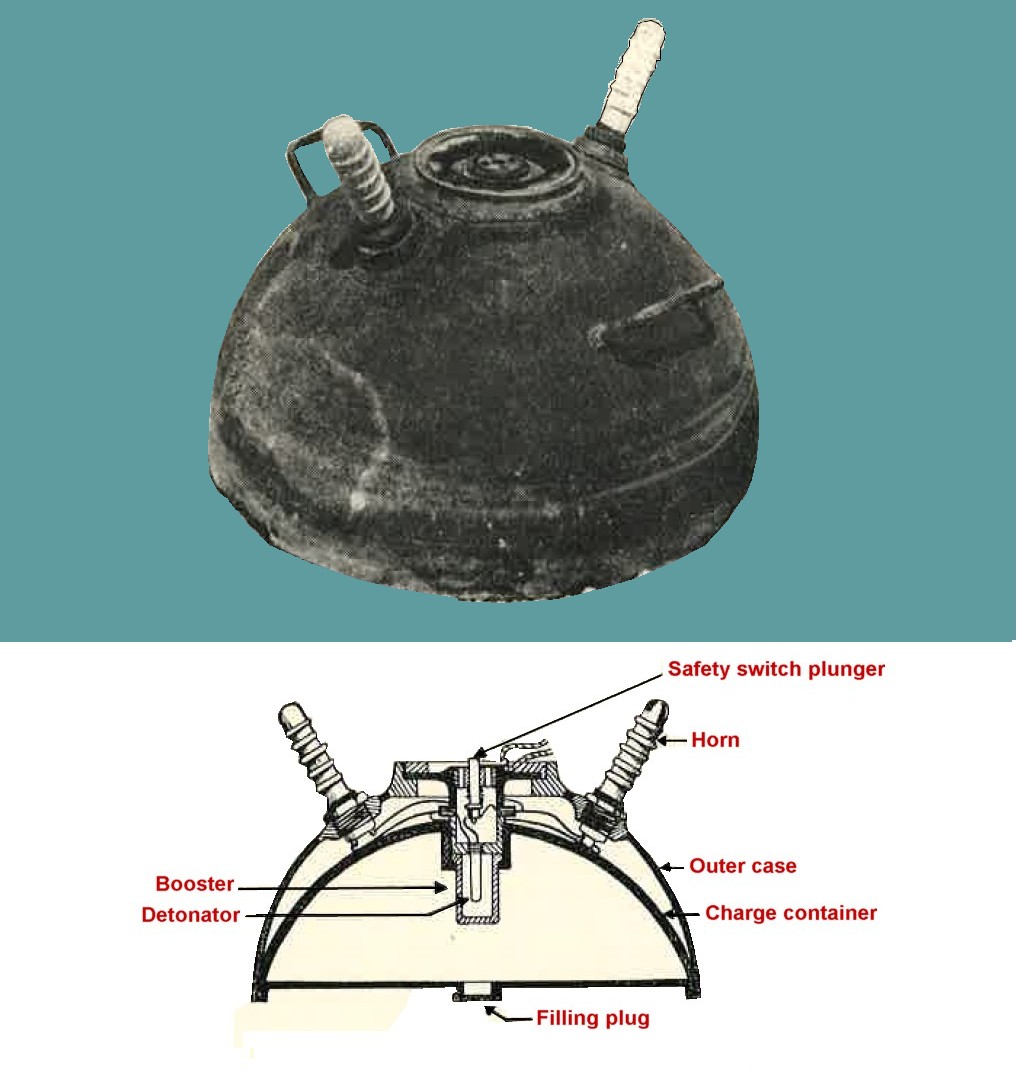
Figure 208. Model 96 (1936) mine. |
Note
Another tyoe of underwater mine, is an 8 1/2 inch by 8 inch canister, total weight 20 pounds, containing 8 pounds of perchlorate explosive.
